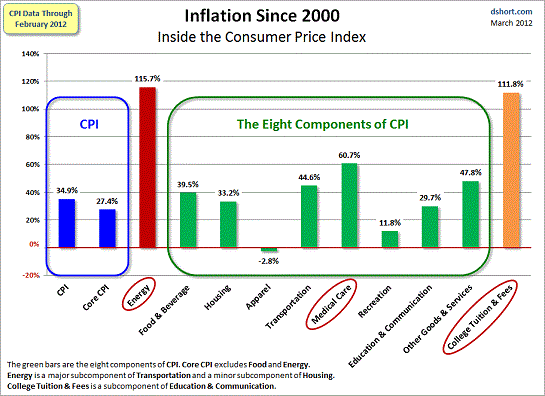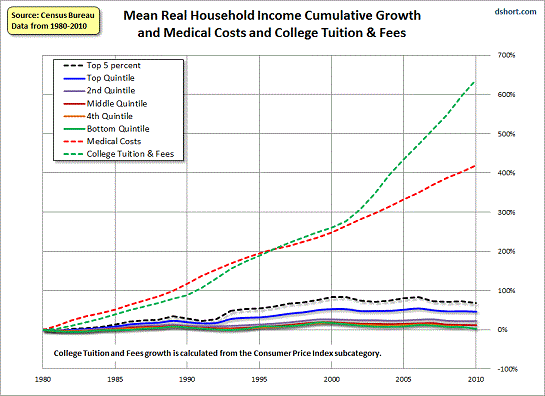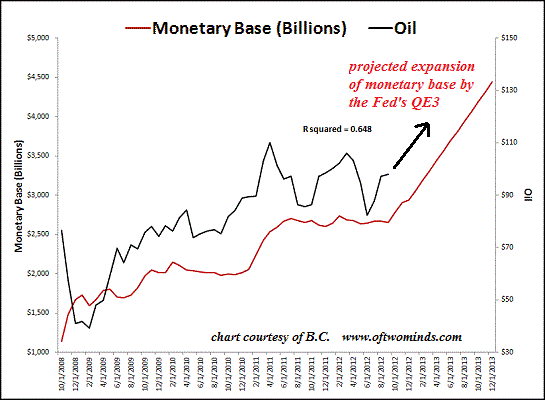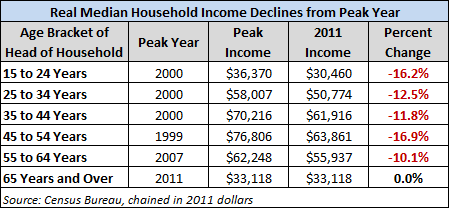Inflation is generally viewed as a monetary phenomenon (print money excessively and you get inflation), but let’s use a very simple definition: any loss of purchasing power. If your income buys fewer goods and services, for whatever mix of reasons (geopolitical, weather, monetary, fiscal, etc.), that’s inflation “on the ground.”
Consider this breakdown of the components that together make up the standard measure of inflation, the Consumer Price Index (CPI): (courtesy of dshort.com) What are the obvious major sources of inflation? Energy, medical costs and college tuition.

Here’s an eye-opening look at medical costs and college tuition, also courtesy ofdshort.com:

What differentiates medical and college costs from everything else? The Federal government’s direct role in these markets. The Central State directly spends over $1 trillion a year on Medicare and Medicaid, and controls private spending with rules and regulations.
As for college costs: could their incredible expansion have anything to do with the Central State backing $1 trillion in student loans?
The Federal government controls much of the economy, directly or indirectly. It influences agriculture prices with price supports and regulatory controls, it influences the cost of housing with gargantuan subsidies (FHA and VA loans) and has basically taken over the entire mortgage market in its effort to re-inflate the housing bubble.
But it is striking that the highest inflation is occurring in precisely those sectors dominated by government spending: medical and college costs.
I was alerted to this correlation by correspondent David P., who wrote:
Inflation is centered in particular markets – not finance, housing or small business, but wherever the government spends money: Schools, food, energy, medical care.
This is of a piece with the previous post on the Federal Reserve’s policy of supporting Federal spending by monetizing Treasury debt Why QE May Not Boost Stocks After All (September 26, 2012). In other words, the Fed doesn’t necessarily create inflation across the entire economy (Why QE Won’t Create Inflation Quite as Expected) by printing money; it creates inflation in government-funded sectors by monetizing Treasury bonds that enable massive Federal spending.
Government spending is by definition unhindered by market forces; having a monopoly on coercion, taxation and selling Treasury bonds to the Federal Reserve means you get to spend money without worrying about price or other market functions.
Government spending that funnels huge sums of money into cartels–for example, the sickcare and higher-education cartels–directly supports monopolistic pricing, which then drives costs higher regardless of the money supply expanding or contracting. This is the basic function of the Statist monopoly capital partnership that dominates our neofeudal economy.
Where the Fed has succeeded is in raising expectations of inflation that then drive speculative bets on higher prices. Part of the “don’t fight the Fed” belief system is if the Fed wants inflation, it will get it. And if that’s the case, then why not buy oil/gold/silver now before prices shoot higher?
The price of oil in the U.S. is influenced by many factors–geopolitical, currency, technology, policy, etc. Nonetheless, the rough correlation between base money supply and the price of oil in dollars is noteworthy:

It’s also worth recalling that the Federal government itself is a major consumer of oil, as the Pentagon alone consumes as much oil as a small industrialized nation.
Government spending and intervention fuel inflation, and the Federal Reserve enables that spending and inflation by monetizing Federal deficits. Raising expectations of inflation has powered oil higher on speculative buying, but it’s difficult to generate economy-wide inflation when wages are declining (courtesy of dshort.com):

Eventually, declining wages lead to demand destruction, as households consume fewer goods and services. But inflation that is being driven by government spending will not decrease, as the demand is being supported by a borrow-and-spend Central State supported by a monetize-Federal-debt-til-Doomsday Federal Reserve.
























